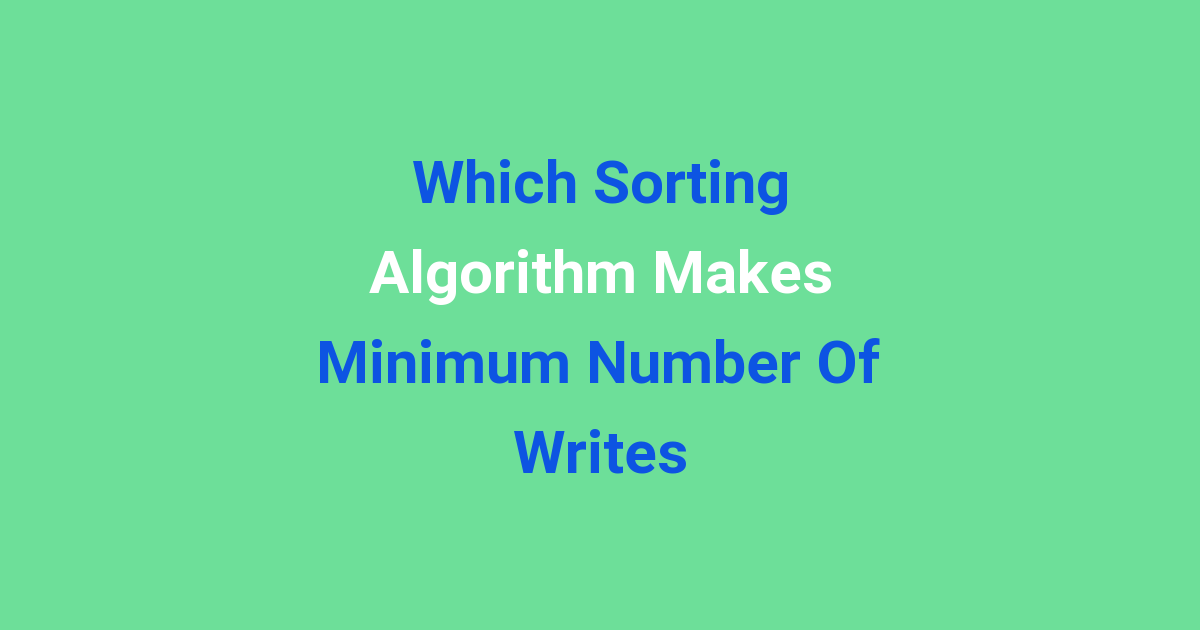Which sorting algorithm minimizes the number of writes made?
Which Sorting Algorithm Makes a Minimum Number Of Writes
Sorting algorithms are fundamental tools in computer science, used to organize data efficiently. When dealing with large datasets, the number of write operations performed by a sorting algorithm can significantly impact performance. In this article, we’ll explore various sorting algorithms and identify which one minimizes write operations.
Understanding Write Operations
Write operations refer to the actions taken by a sorting algorithm to rearrange elements in the dataset. These operations involve modifying the order of elements, such as swapping them or moving them within the data structure being sorted.
The Importance of Minimizing Writes
Reducing the number of write operations is crucial for optimizing sorting algorithms, especially when dealing with large datasets. Fewer writes mean less memory access and faster execution, leading to improved overall performance.
Bubble Sort: A Simple Starting Point
Bubble sort is one of the simplest sorting algorithms to understand. It works by repeatedly stepping through the list, comparing adjacent elements, and swapping them if they are in the wrong order. While bubble sort is easy to implement, it tends to perform poorly on large datasets due to its high number of write operations.
function bubbleSort(arr) {
let n = arr.length;
for (let i = 0; i < n-1; i++) {
for (let j = 0; j < n-i-1; j++) {
if (arr[j] > arr[j+1]) {
// Swap arr[j] and arr[j+1]
let temp = arr[j];
arr[j] = arr[j+1];
arr[j+1] = temp;
}
}
}
}
Insertion Sort: Another Simple Option
Insertion sort is another straightforward sorting algorithm. It builds the final sorted array one element at a time by repeatedly taking the next element and inserting it into the proper position among the already sorted elements. Like bubble sort, insertion sort can result in a high number of write operations.
function insertionSort(arr) {
let n = arr.length;
for (let i = 1; i < n; i++) {
let key = arr[i];
let j = i - 1;
while (j >= 0 && arr[j] > key) {
arr[j + 1] = arr[j];
j = j - 1;
}
arr[j + 1] = key;
}
}
Selection Sort: A Different Approach
Selection sort divides the input list into two parts: the sublist of items already sorted and the sublist of items remaining to be sorted. It repeatedly selects the smallest element from the unsorted sublist and moves it to the end of the sorted sublist. While selection sort also involves write operations, it typically performs fewer than bubble sort or insertion sort.
function selectionSort(arr) {
let n = arr.length;
for (let i = 0; i < n-1; i++) {
let min_idx = i;
for (let j = i+1; j < n; j++) {
if (arr[j] < arr[min_idx]) {
min_idx = j;
}
}
let temp = arr[min_idx];
arr[min_idx] = arr[i];
arr[i] = temp;
}
}
Merge Sort: Divide and Conquer
Merge sort is a divide-and-conquer algorithm that divides the input array into two halves, sorts each half independently, and then merges the sorted halves. While merge sort performs more comparisons than other algorithms, it minimizes write operations by efficiently merging the sorted halves.
function mergeSort(arr) {
if (arr.length <= 1) {
return arr;
}
const middle = Math.floor(arr.length / 2);
const left = arr.slice(0, middle);
const right = arr.slice(middle);
return merge(mergeSort(left), mergeSort(right));
}
function merge(left, right) {
let resultArray = [], leftIndex = 0, rightIndex = 0;
while (leftIndex < left.length && rightIndex < right.length) {
if (left[leftIndex] < right[rightIndex]) {
resultArray.push(left[leftIndex]);
leftIndex++;
} else {
resultArray.push(right[rightIndex]);
rightIndex++;
}
}
return resultArray.concat(left.slice(leftIndex)).concat(right.slice(rightIndex));
}
Conclusion
Choosing the right sorting algorithm is crucial for optimizing the performance of your code. While simpler algorithms like bubble sort and insertion sort are easy to understand, they may not be the most efficient for large datasets due to their high number of write operations. Selection sort improves upon these by reducing the number of write operations, but it still may not be the best choice for very large datasets. Merge sort, with its divide-and-conquer approach, stands out as an efficient algorithm that minimizes writes and offers better performance overall. By understanding the characteristics of each sorting algorithm, you can make informed decisions to optimize your code for efficiency and scalability.
